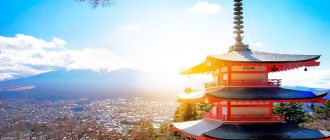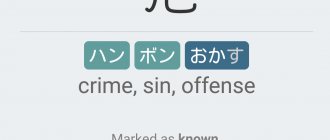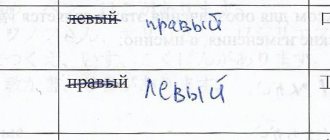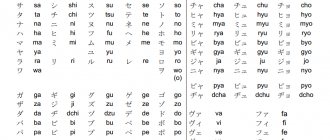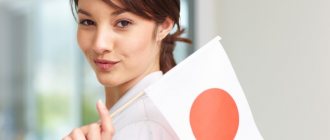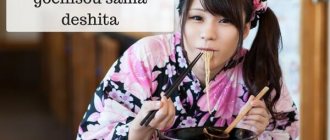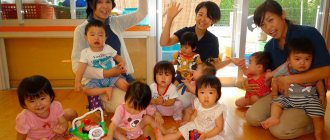Home / Japanese lessons / Hiragana
Hiragana (平仮名) is the Japanese syllabary, one of the components of Japanese writing along with katakana, hieroglyphs, Arabic numerals and Romaji (Roman alphabet). Hiragana and katakana together make up the kana system, in which one character expresses one mora. The kana sign can convey a vowel sound (for example, "a" あ); a combination of a consonant followed by a vowel (for example, “ta” た), or a nasal sonant “n” ん, which, depending on the context, can sound like Russian n, m, English ng or French nasal vowels. Hiragana is used for words that do not have kanji, including particles such as made まで and suffixes such as san さん.
Here you can:
- the entire Gojuon table of the Hiragana syllabary.
- View the order in which each syllable is written in the Hiragana alphabet.
- Download the copybook for each syllable of the Hiragana alphabet.
- Listen to the correct pronunciation.
- Read children's stories in hiragana
- Take the Hiragana knowledge test.
- New memory development game “Find the Pair” for Hiragana.
Where to begin?
If you are already familiar with all the hiragana characters, we recommend that you start by reviewing the basics. You have to find out the hiragana sign and choose the correct one from the list of answers. Proceed to the next section only if you are sure that you have a good memory of the Japanese writing characters. The tasks may seem difficult at first. Don't be afraid of mistakes! Practice regularly for 10-15 minutes a day, and within 2 weeks you will be able to achieve good results. Remember, hiragana is the basis of Japanese writing. The stronger your basic knowledge, the easier it will be for you at the first stage of studying at a language school.
| Basics of Hiragana Dakuten and Handakuten Almost all hiragana Yeon All hiragana Go to katakana |
Many thanks to Dmitry Budaragin (twitter) for the test. And also to Anton Gnatyuk for improving the test and creating new ones.
Hiragana. 5 Ways to Learn Hiragana
If you just can’t learn the Japanese alphabet Hiragana, then learn about 5 ways to memorize and choose the method that suits you.
So, let's start with the simple ones:
1. Write down each sign , saying it out loud as many times as necessary to remember it. Cramming helps some people.
2. Remember the signs using A4 size cards . Make large cards: on one A4 sheet, write one hiragana sign large with a bright marker, and at the bottom, small, so as not to catch the eye (you can use a pen), sign the reading of this sign. Hang them on the walls of your room or apartment. Every time the cards come into your field of vision, try to remember how the sign is read. If you can't remember, look at the bottom of the card to read the sign. Before this task, you can practice a little hiragana.
Important! Be careful not to damage the walls when attaching the cards.
3. Remember the signs using small cards . Cut small cards from paper or cardboard and write one hiragana character on one side and its reading on the other. We look at the sign and try to remember how it is read. Such small cards are convenient to take with you and repeat, for example, in transport, in line, etc.
4. Cut small cards from paper or cardboard , as in the previous method. Unlike previous cards, there is no need to write the reading of the sign on the back. Place these cards on the table with the signs facing down and, pulling out one card at a time, try to read the sign. If you can read it, put the card aside. If you couldn’t read the sign, we return the card back to its original place. The goal is to read all the signs and put them aside. First you need to work out these signs a little.
5. Make combinations of characters or some words from small cards (even if they are not in Japanese) and try to read them. Find out 5 more ways to memorize hiragana, with which you will learn not only to read them, but also to write them correctly - sign up for the free webinar “All about the Japanese alphabet hiragana” using this link: https://vsyo-o-hiragane-vebreg.plp7 .ru/
WHAT ELSE WILL BE ON THE WEBINAR:
* Analysis of the table of hiragana characters. How to pronounce them correctly
* Voiced and unvoiced sounds. How are they formed?
* Formation of syllables with the signs や/ya、ゆ/yu、よ/yo. How to read correctly
* Formation of long sounds
* Double consonants
* 10 ways to learn the Hiragana alphabet
* Learn the first row of hiragana characters through associations
* Receive a Gift Certificate in honor of the upcoming New Year. This is definitely not to be missed!
*Receive a bonus if you stay at the webinar until the end
Sign up for the webinar via the link https://vsyo-o-hiragane-vebreg.plp7.ru/ and see you online!
What methods of memorizing hiragana have you used or are you using now?
This is a useful read:
- Japanese lessons. The story "My Room" in Japanese. Natalia
- 3 Helpful Tips for Learning Japanese
- Japanese for beginners. Flash mob in Japanese “Open a window to Japan!”
Tagged 5 ways to learn hiragana all about hiragana how to learn hiragana learning hiragana hiragana Japanese alphabet hiragana
Hiragana and script characters
Features of the table
- Spell the sign by clicking on the picture,
- Copybooks in PDF format.
| A | And | at | uh | O |
| ka | ki | ku | ke | co |
| sa | si | su | se | with |
| that | you | tsu | te | That |
| on | neither | Well | ne | But |
| Ha | hee | ugh | heh | xo |
| ma | mi | mu | meh | mo |
| I | Yu | e | ||
| ra | ri | RU | re | ro |
| va | n | o (pad.) |
(RTF, 219K) Go to katakana
Japanese alphabet Hiragana
Japanese alphabet hiragana. Click on the picture to enlarge it. If you are interested in learning Japanese, you have probably heard the word “hiragana”.
What is it? Hiragana is one of the syllabary alphabet of the Japanese language , and there are two of them. The second alphabet is called “katakana” and we will talk about it in the next article.
So, the Hiragana alphabet is used to write native Japanese words, as well as Japanese names.
Hiragana in Japanese is also used instead of kanji when it is assumed that the reader does not know any kanji. The reading of hieroglyphs is also written with hiragana signs above or below the words. For example, 大学(だいがく) /daigaku/ daigaku – “institute”. This reading of hieroglyphs is called “furigana”.
As mentioned above, the Hiragana alphabet is a syllabic alphabet, and this means that one letter or sign contains 2 sounds, i.e. a syllable.
In hiragana, as in katakana, there are also signs that contain only one sound - a vowel. This is the very first row of characters from the あ(a) sign to the お(o) sign. In the last row there are also 2 characters in which there is only one sound - this is another sign を (o). Thus, there are 2 characters in hiragana that are read as “o” - お and を.
When are these signs used? The sign お (o) from the first row is written in words, for example, おはようございます /ohayo:gozaimas(u) / ohayo:gozaimas(u) / “good morning”, and the sign を (o) from the last row of hiragana is used as grammatical particle, which is also called the indicator of the accusative case, and is never written in words. For example, ほんを よみます/ hon o yomimas(u) / hon o yomimas(u), where the word ほん/hon/hon means “book”, よみます/yomimas(u) /yomimas(u) – “read”, i.e., this phrase completely means “read (who? what? – blame. case) book.” を is not translated.
And there is another sign in which there is only one sound - this is the very last hiragana character - the sign ん / n / n.
I would also like to draw your attention to 2 signs from the 6th row of the table. They are similar and differ only in some details. This is the first character of this series - は / ha / ha and the last character of the same series - the sign ほ / ho / ho:
は - ほ
The sign は / ha / ha has one horizontal line in the upper right part, and a vertical line intersects it. The sign ほ / ho / ho has two horizontal lines in the upper right part, and the vertical line does not intersect the upper horizontal line.
In addition, as practice has shown, those starting to study hiragana very often get confused in writing the following characters, since they are very similar:
あ /a-お/o
き / ki / ki -さ / sa / sa
ぬ / nu / well-め / me / me
は / ha / ha -ほ / ho / ho -ま / ma / ma
ね / ne / ne -れ / re / re -わ / wa / wa
る / ru / ru-ろ / ro / ro
Be careful when writing these signs!
If you are just starting to learn Japanese and want to learn hiragana, katakana, and also want to learn how to write words in Japanese and construct sentences in Japanese, then sign up for free video lessons <<<here>>> .
If you already know both hiragana and katakana, did you find it difficult to remember these characters? How did you remember similar signs? Share your experience in the comments below!
This is a useful read:
- Neutral polite speech style
- Japanese language. Japanese words. Transport in Japanese
- Japanese account. Hieroglyphs-numbers
Hiragana
The form of hiragana characters comes from the Chinese cursive caoshu
(Japanese so: sho). The picture shows an example of the cursive script of the Tang Dynasty calligrapher Sun Guoting (c. 650 AD)
Hiragana is derived from Man'yogana
- a writing system that arose in the 5th century AD.
e., in which Japanese words were written in similar-sounding Chinese characters. Hiragana characters are Man'yogana written in the Caoshu
of Chinese calligraphy. The figure below shows the process of the origin of hiragana characters from man'yogana through tsaoshu. The top part shows a character in the form of kaishu (kaisho), the middle part shows a character written in the caoshu style, and the bottom part shows a hiragana character.
The oldest hiragana text discovered was inscribed on clay shards located in the house of Fujiwara no Yoshimi. They are dated to 866 or earlier[5]. Before the discovery of these shards, the oldest hiragana text was a document written by Deputy Governor Sanuki.
When hiragana was created, not everyone received it positively. Many continued to believe that Chinese should remain the language of the educated part of the population. In Japan, historically the kanji form of kaisho
used by men and called
otoe
(Japanese 男手), “men's writing,” and the tsaoshu form was more often used by women.
Therefore, at first, hiragana became popular among Japanese women who did not have access to a good education. Therefore, an alternative name for hiragana is onnade
(Japanese 女手) “women’s writing.” For example, Genji Monogatari and other early women's novels were written primarily or exclusively in hiragana.
Among men, hiragana began to be used later, but it was perceived as a license. Hiragana, with its flowing forms, was used in informal correspondence, while documents used the more formal katakana and kanji. Today, the uses of hiragana and katakana are separated, and when Japanese words are written in kana, only hiragana is used. However, texts exclusively in Hiragana are now found only in books for preschool children. For ease of reading, such books have spaces between words.
Initially, each mora could be written in different hiragana characters, derived from different hieroglyphs. In 1900, the system was simplified, and a single sign was assigned to each sound. Alternative hiragana characters are known as hentaigana (変体仮名) (“unusual kana”) and have a limited scope today.
Hiragana-Kiriji table[edit]
The table shows the hiragana characters along with their syllabic representation in Cyrillic (according to the system of E. D. Polivanov). The abolished kana signs are highlighted in red. There are 47 basic hiragana characters and 104 basic combinations.
| vowels | 拗音yo:he | ||||||
| A | And | at | uh | O | (I ) | (Yu ) | (e ) |
| ka | ki | ku | ke | co | きゃkya | きゅkyu | きょkyo |
| sa | si | su | se | with | しゃsya | しゅshu | しょsho |
| that | you | tsu | te | That | ちゃcha | ちゅtu | ちょcho |
| on | neither | Well | ne | But | にゃnya | にゅnu | にょnyo |
| Ha | hee | ugh | heh | xo | ひゃhya | ひゅhyu | ひょhyo |
| ma | mi | mu | meh | mo | my name | みゅmu | みょmyo |
| I | Yu | e | |||||
| ra | ri | RU | re | ro | りゃrya | りゅryu | りょryo |
| va | in and | ve | O | ||||
| n | |||||||
| がha | ぎgi | ぐgu | げge | ごgo | ぎゃgya | ぎゅgyu | ぎょgyo |
| ざza | じji | ずzu | ぜze | ぞzo | じゃja | じゅju | じょjo |
| Yes _ | ぢ(ji) | づ(zu) | でde | どto | ぢゃ(ja) | ぢゅ(ju) | ぢょ(jo) |
| ばba | びbi | ぶbu | べbe | ぼbo | びゃbya | びゅbu | びょbyo |
| ぱpa | ぴpi | ぷpu | ぺpe | ぽby | ぴゃpya | ぴゅpyu | ぴょпё |
The sequences にゃ, にゅ and にょ should not be confused with the combinations んや, んゆ and んよ: in the first case a whole mora is formed, and in the second - two separate sounds. For example, かにゅうka-nu-u
“adherence” and かんゆう
ka-n-yu-u
“belief”.
These words are easily distinguishable by ear. To distinguish such words during Cyrillization,
a hard sign is placed
n kanyu:
.
Origin[edit]
The form of the hiragana characters is derived from the Chinese cursive caoshu
. The picture shows an example of the cursive script of the Tang Dynasty calligrapher Sun Guoting (c. 650 AD)
Hiragana is derived from Man'yogana
- a writing system that arose in the 5th century AD.
e., in which Japanese words were written in similar-sounding Chinese characters. Hiragana characters are Man'yogana written in the Caoshu
of Chinese calligraphy. The figure below shows the process of the origin of hiragana characters from man'yogana through tsaoshu. The top part shows a character in the kaisho form, the middle part shows a character written in the caoshu style, and the bottom part shows a hiragana character.
When hiragana was created, not everyone received it positively. Many continued to believe that Chinese should remain the language of the educated part of the population. In Japan, historically the kanji form of kaisho
was used by men and was called
onode
(Japanese 男手?), “men's writing,” and the tsaoshu form was more often used by women.
Therefore, at first, hiragana became popular among Japanese women who did not have access to a good education. Therefore, an alternative name for hiragana is onnade
(Japanese 女手?) “women’s writing.” For example, Genji Monogatari and other early women's novels were written primarily or exclusively in hiragana.
Among men, hiragana began to be used later, but it was perceived as a license. Hiragana, with its flowing forms, was used in informal correspondence, while documents used the more formal katakana and kanji. Today, the uses of hiragana and katakana are separated, and when Japanese words are written in kana, only hiragana is used. However, texts exclusively in Hiragana are now found only in books for preschool children. For ease of reading, such books have spaces between words.
Initially, each mora could be written in different hiragana characters, derived from different hieroglyphs. In 1900, the system was simplified, and each sound was assigned a single sign. Alternative hiragana characters are known as hentaigana (変体仮名?) (“unusual kana”) and have a limited scope today.
Poem by Iroha-uta
(
song of flowers
), written in the 10th century, uses all hiragana characters once, with the exception of
n
ん. Below is the Cyrillic reading of the original hiragana; the modern Japanese reading, different from the ancient one, is shown in parentheses.
Notice that the last line begins with the abolished kana ( ve
ゑ)
| いろはにほへと | I ro ha ni ho he to (Iro wa nyoedo) | Beauty shines for a moment - |
| ちりぬるを | ti ri nu ru vo (tirinuru o) | And everything withered away. |
| わかよたれそ | wa ka yo ta re so (waga yo tare dzo) | In our world, what, tell me, |
| つねならむ | tsu ne na ra mu (tsune naran) | Lasts forever? |
| うゐのおくやま | u vi no o ku ya ma (ui no okuyama) | The edges of the world of vanity |
| けふこえて | ke fu ko e te (kyo: koete) | Now go over |
| あさきゆめみし | a sa ki yu me mi si (asaki yume misi) | Stop dreaming empty dreams |
| ゑひもせす | ve hi mo se su (yoi mo sezu) | And get drunk from them![1] |


